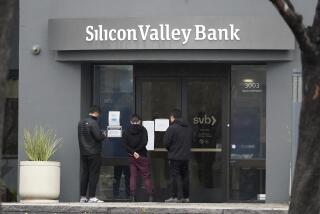Keating Asks to Get Lincoln S&L; Back for Taxpayers’ Sake
- Share via
WASHINGTON — Charles Keating, the former chairman of the failed Lincoln Savings & Loan Assn., asked a federal judge Tuesday to let him operate the thrift under judicial supervision.
Keating told U.S. District Judge Stanley Sporkin that he could invest “every ounce of my energy” but no cash into the Irvine, Calif., thrift if it is returned to him.
Why no cash?
“I’m completely broke, as is all of my family,” Keating said. “We’re absolutely broke as a result of this debacle.”
“My question,” Sporkin asked, “is how can someone say, ‘Here, take it back,’ and expose $4 billion in depositors’ money to someone’s promise?”
Keating replied that he could save taxpayers’ money by operating Lincoln’s assets instead of liquidating them as part of the government’s thrift bailout effort.
“Something else has to be tried. Something has to make history,” he said. “You always look back in the court of history. Here you can make it.”
The exchange took place during a pretrial hearing on a government motion seeking to dismiss a lawsuit Keating filed last May seeking the return of Lincoln, which was seized by the government last April.
Regulators have estimated that protecting Lincoln’s depositors from losses could cost taxpayers as much as $2.5 billion, a figure Keating disputes. The government also has filed a $1-billion fraud and racketeering suit against the Arizona executive.
Keating told Sporkin that with his expertise, combined with the talents of former Lincoln employees, the thrift could be operated profitably, preventing any losses to depositors. He submitted a package of resumes of former employees for Sporkin’s review.
“The bondholders would recover, the taxpayers would have no loss, we could outperform anybody else with the assets we’ve assembled,” Keating said. “I think it would be great to return Lincoln without any liquidation.”
Keating’s proposal came near the close of his fifth day on the witness stand and moments before his attorneys rested their case.
Earlier in the day, Keating’s attorneys produced a government memo showing that federal examiners miscalculated Lincoln’s net worth by $60 million.
Attorneys for Lincoln said the memo is significant because regulators ordered Lincoln to operate under government-issued supervisory directives after finding the thrift to be undercapitalized.
The directives limited the types of transactions the thrift could make.
The memo, dated Feb. 17, 1989, less than two months before the government seized the Irvine thrift, was addressed to the regulators in charge of overseeing the examination of Lincoln.
“Obviously, I find this error, if verified, most distressing--not because it changes my view of Lincoln and what has and will have to be done, but because of how Lincoln will use it,” wrote Alvin Smuzynski, a senior regulatory official with the Office of Regulatory Affairs, a division of the Federal Home Loan Bank Board.
In an interview, Kevin O’Connell, who supervised the government’s examination of Lincoln, discounted the memo as being based on “first blush” numbers and said the mathematical error was never verified.
“There was no mistake by examiners,” he said.
“The gentleman either can’t add or he’s a liar,” responded Keating outside the courtroom.
Keating’s attorneys also produced a 1985 letter from Alan Greenspan, then a private economist and now chairman of the Federal Reserve Board, urging regulators to grant Lincoln an exemption from stricter direct-investment rules.
Greenspan wrote that denial of an exemption “would work a serious and unfair hardship on an association that has, through its skill and expertise, transformed itself into a financially strong institution that presents no foreseeable risk to the Federal Savings and Loan Insurance Corp.”
Keating’s attorneys attribute the demise of Lincoln to a “vendetta” by regulators incensed over Keating’s opposition to the direct-investment rule.
More to Read
Inside the business of entertainment
The Wide Shot brings you news, analysis and insights on everything from streaming wars to production — and what it all means for the future.
You may occasionally receive promotional content from the Los Angeles Times.










